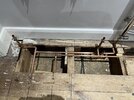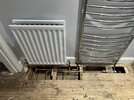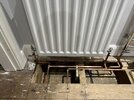its called belt and braces and it is not uncommon for a yorkshire fitting to not run properlyI can’t think why anybody would try and add more
You are using an out of date browser. It may not display this or other websites correctly.
You should upgrade or use an alternative browser.
You should upgrade or use an alternative browser.
Yorkshire fittings advice please.
- Thread starter Heatslave
- Start date
Sponsored Links
I’ve found soldered joints surprisingly forgiving, even if they are are slightly misaligned or fitting a bit bent, capillary action seems to fill up the joint and seal it.
Having done a few now, I am way more confident of a solder joint lasting than push fit + there’s no chance of mice chewing the pipe
Having done a few now, I am way more confident of a solder joint lasting than push fit + there’s no chance of mice chewing the pipe
I was taught at College, (a loooong time ago), Yorkshire fittings contain about 3x the solder actually needed to make the joint. However, its a sight easier to make the joint right first time around, (rather than trying to drain the pipework and redo the joint), so I've always added a little to ensure a sound joint first time round!
Interesting, do they still contain that amount, or is it something manufacturers would scrimp on?I was taught at College, (a loooong time ago), Yorkshire fittings contain about 3x the solder actually needed to make the joint. However, its a sight easier to make the joint right first time around, (rather than trying to drain the pipework and redo the joint), so I've always added a little to ensure a sound joint first time round!
Sponsored Links
I was always taught, flux never goes on the fitting only on the pipe, same with the glue on SW.throw liberal amounts of flux at every fitting
If flux is added into the fitting, then when the pipe is pushed in, it pushes flux into the fitting, flux then pools in the fitting when heated and it draws some of the solder down into the fitting. That can end up causing restrictions in the pipe, especially if more too much solder is added.
Coat the outside of the pipe all the way around with flux, push on the fitting, twisting as it goes on if possible, then clean off the excess that pushes out the top edge before heating. That should be more than enough flux. Don't forget to clean the fitting with a damp cloth once made to wipe off any flux residue, that'll stop the fitting going green later on and leaves it clean.
When you’re not doing it every day, it’s definitely hard work for a DIY’er. Talk about pressure to get it right !!I practised endlessly and could never get the solder to flow, either under or over heating the pipe and flux. Then it just came right, cant explain how and I've not looked back.
Because I had a lot to do I invested in a good quality Rothenberger torch and blue gas bottle. I believe having that, and being able to control the flame so well, helped me a lotFor diyers you would be better with a primus gas bottle and nozzle it burns cooler than the other gases and less chance of over cooking the fittings .
Bottles dear to start with but less than a tenner for a refill from city plumbing and the likes
Mine were all under the floorboards so well hidden. Getting a clean finish is definitely one notch up on the skill setWhen you’re not doing it every day, it’s definitely hard work for a DIY’er. Talk about pressure to get it right !!. I’ve managed to do multiple radiators and pipe runs, but the joints are a disgrace
. Just shows what a skilled job it is to do right. You can see why people resort to Speedfit

It’s just the way I was taught by someone who was supposed to know what he was doing….as a “guarantee not to leak” sort of thing. Lesson learned though, I’ll give it a go withoutThe only time I’ve used Yorkshire fittings I found there was plenty of solder, easily as much as I put in for an end feed.
I can’t think why anybody would try and add more
Same here…..living the dream !!Mine were all under the floorboards so well hidden. Getting a clean finish is definitely one notch up on the skill set
Just to add, as Notch7 mentions...
I regularly teach students to solder electronics - one of the first things I get them to do, is to try and solder a component onto a tarnished piece of stripboard, and then onto a polished piece.
The difference between the two, for ease of soldering and quality of finish is huge.
So, as well as polishing the pipe, ensure the inside of the Yorkshire fitting is also cleaned up.
I prefer to use scotchbrite for cleaning copper (both for PCBs and plumbing). It polishes up the copper without leaving rusty wire wool remnants to clean up!
Cleanliness is everything when soldering.I always clean inside the joint and the pipe ends,
I regularly teach students to solder electronics - one of the first things I get them to do, is to try and solder a component onto a tarnished piece of stripboard, and then onto a polished piece.
The difference between the two, for ease of soldering and quality of finish is huge.
So, as well as polishing the pipe, ensure the inside of the Yorkshire fitting is also cleaned up.
I prefer to use scotchbrite for cleaning copper (both for PCBs and plumbing). It polishes up the copper without leaving rusty wire wool remnants to clean up!
I've used loads of yorkshire fittings when redoing plumbing in our house and never added extra solder- a great invention for sure. The main benefit I find (with the assistance of a decent rothenberger torch as mentioned above) is the ability to solder one handed when joints situated in various cavities/under floorboards etc. In addition, with the use of a soldering mat secured by panel pins to prevent me setting fire to anything.
The main benefit I find (with the assistance of a decent rothenberger torch as mentioned above) is the ability to solder one handed when joints situated in various cavities/under floorboards etc. In addition, with the use of a soldering mat secured by panel pins to prevent me setting fire to anything.
Yep, unlike most DIY torches, you get a nice, hot, and tight pencil frame, and auto-ignition, or off, at the touch of a button. Nothing DIY comes close.
Well, I finally got round to my little plumbing job using Yorkshire fittings….adding a panel radiator to the bathroom 
Although I was soooo tempted, I resisted the urge to add a little bit more solder to the Yorkshire fittings, and guess what….no leaks

Just for complete disclosure, there were a couple of joints I added a bit of extra solder, they just didn’t look right and I didn’t want to risk it
Thanks very much for the advice everyone. I don’t know how you do this every day, I hate plumbing with copper, so stressful for a DIY’er
Although I was soooo tempted, I resisted the urge to add a little bit more solder to the Yorkshire fittings, and guess what….no leaks
Just for complete disclosure, there were a couple of joints I added a bit of extra solder, they just didn’t look right and I didn’t want to risk it
Thanks very much for the advice everyone. I don’t know how you do this every day, I hate plumbing with copper, so stressful for a DIY’er
Attachments
- Joined
- 25 Apr 2016
- Messages
- 2,610
- Reaction score
- 619
- Country

I used to have problems galore with copper plumbing. In the end I discovered I was using to much heat not to little. Nowadays I find it's easier, quick and simple.
DIYnot Local
Staff member
If you need to find a tradesperson to get your job done, please try our local search below, or if you are doing it yourself you can find suppliers local to you.
Select the supplier or trade you require, enter your location to begin your search.
Please select a service and enter a location to continue...
Are you a trade or supplier? You can create your listing free at DIYnot Local
Sponsored Links
Similar threads
- Replies
- 8
- Views
- 941
- Replies
- 29
- Views
- 5K
- Replies
- 7
- Views
- 12K



